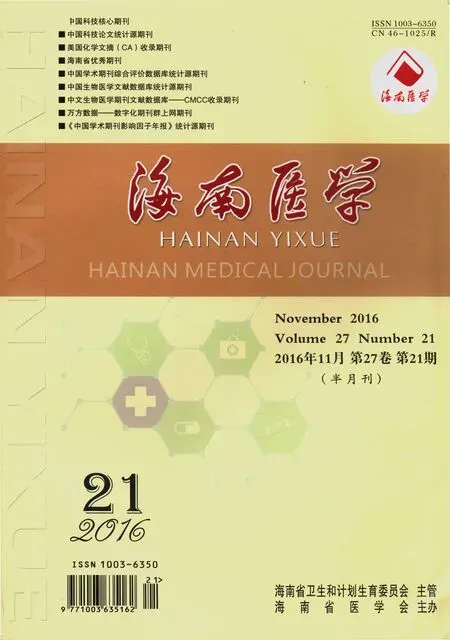血清谷氨酸水平对脑梗死后抑郁发病的影响
余学婕,徐鸿,周春秀
(百色市人民医院神经内科,广西百色533000)
血清谷氨酸水平对脑梗死后抑郁发病的影响
余学婕,徐鸿,周春秀
(百色市人民医院神经内科,广西百色533000)
目的探讨血清谷氨酸水平对脑梗死后抑郁(PCID)发病的影响。方法选取我院神经内科2013年11月至2015年8月期间收治的80例急性脑梗死患者,于脑梗死后第2周根据《美国精神障碍诊断与统计手册》躯体疾病所导致的心境障碍诊断标准,对80例患者进行脑梗死后抑郁诊断,采用汉密尔顿抑郁量表(HDRS)评估脑梗死后患者的抑郁程度,美国国立卫生研究院卒中量表(NIHSS)评估神经功能缺损程度,使用高效液相色谱技术检测梗死后抑郁患者与非梗死后抑郁患者血清谷氨酸水平,采用多因素Logistic回归分析血清谷氨酸水平对PCID发病的影响。结果入组两周后,80例脑梗死患者共诊断为PCID 28例,PCID发生率为35.0%,其中轻度抑郁15例(53.6%),中度抑郁8例(28.6%),重度抑郁5例(17.8%);PCID患者入院时NIHSS评分为(7.4±2.4)分,梗死后两周评分为(5.6±1.8)分;非PCID患者入院时NIHSS评分为(6.1±1.7)分,梗死后2周评分为(3.4±1.2)分。PCID患者入院时及梗死后2周,NIHSS评分均显著高于非PCID患者,差异均有显著统计学意义(P<0.01);PCID患者梗死后第2天和梗死后两周血清谷氨酸水平分别为(4.5±1.8)g/L、(6.9±2.3)g/L,非PCID患者梗死后第2天和梗死后两周血清谷氨酸水平分别为(6.8±2.1)g/L、(7.1±1.9)g/L,PCID患者脑梗死后两周血清谷氨酸水平显著高于第2天,差异有统计学意义(P<0.01);非PCID患者血清谷氨酸水平前后比较差异无统计学意义(P>0.05);梗死后第2天,PCID患者血清谷氨酸水平显著低于非PCID患者(P<0.01),但梗死后两周,PCID患者和非PCID患者血清谷氨酸水平比较差异无统计学意义(P>0.05);PCID患者脑梗死后第2天血清谷氨酸水平与脑梗死后第两周HDRS评分呈负相关(r=-0.301,P<0.05);多因素Logistic回归分析显示,脑梗死血清谷氨酸水平升高是PCID的发生独立危险因素(OR=0.335;95%可信区间为0.139~0.811;P<0.05)。结论PCID的发生可能与卒中患者血清谷氨酸水平升高相关。
谷氨酸;脑梗死;抑郁;危险因素
脑梗死是指局部脑组织因血液循环障碍,缺血、缺氧而发生的软化坏死,部分卒中患者患病后可能出现脑梗死后抑郁[1]。脑梗死后抑郁主要表现为情绪低落、自罪自责、兴趣丧失等情感性心境障碍,约20%~60%的患者在卒中两周内出现脑梗死后抑郁(post-cerebral infarction depression,PCID)[2],严重影响患者康复治疗的积极性,延缓神经功能的恢复、认知功能的好转,增加患者的致残率、复发率及致死率,加重患者及家属的负担[3-4]。脑梗死后精神重度抑郁者占10%~25%,轻度抑郁者占10%~40%。既往研究表明,缺血性脑梗死患者的体内谷氨酸存在代谢障碍,血清谷氨酸水平与PCID的发病密切相关[5]。本研究主要探讨血清谷氨酸水平对脑梗死患者抑郁发病的影响,现报道如下:
1 资料与方法
1.1 一般资料选取本院2013年11月至2015年8月期间收治的80例急性缺血性脑梗死患者。纳入标准:①符合1995年全国第四届脑血管病学术会议制定的诊断标准[6],并由MRI或CT证实的初次患者;②年龄≥18岁;③既往无抑郁或其他精神病史及认知功能障碍;④排除合并严重代谢性疾病患者;⑤排除发病前有抗抑郁药物治疗史者。80例患者中男性48例,女性32例,年龄42~82岁,平均(64.8±7.8)岁。所有患者入院后均行改善脑部循环、营养神经等对症治疗。
1.2 资料收集详细记录所有患者的基线资料,包括年龄、性别、既往病史(包括糖尿病、高血压、冠心病等)、以及神经功能缺损程度,神经功能缺损程度依据美国国立卫生研究院卒中量表(National Institutes of Health Stroke Scale,NIHSS)评定[7]。
1.3 血清谷氨酸水平检测分别于患者脑梗死后第2日及第2周晨6点空腹抽取静脉血,采用高效液相色谱技术检测血清谷氨酸水平。
1.4 PCID诊断所有患者均于脑梗死后第2周根据《美国精神障碍诊断与统计手册》躯体疾病所导致的心境障碍诊断标准对脑梗死后抑郁进行诊断,以汉密尔顿抑郁量表(hamilton Depression Rating Scale, HDRS)评估脑梗死后的抑郁程度,7~17分为轻度抑郁,18~24分为中度抑郁,≥25分为重度抑郁,分值越高表明抑郁程度越严重。
1.5 统计学方法应用SPSS20.0统计软件进行数据分析,计量资料以均数±标准差(±s)表示,组间比较采用t检验;计数资料用率表示,组间比较采用χ2检验;采用Spearman相关分析检测血清谷氨酸水平与PCID严重程度相关性;采用多因素Logistic回归分析血清谷氨酸水平及入院NIHSS评分对PCID发病的影响,以P<0.05为差异有统计学意义。
2 结果
2.1 一般情况入组两周后,80例脑梗死患者共诊断为PCID 28例,PCID发生率为35.0%,轻度抑郁15例(53.6%),中度抑郁8例(28.6%),重度抑郁5例(17.8%)。PCID患者入院时HINSS评分为(7.4±2.4)分,梗死后两周评分为(5.6±1.8)分;非PCID患者入院时NIHSS评分为(6.1±1.7)分,梗死后两周评分为(3.4± 1.2)分。PCID患者入院时及梗死后两周NIHSS评分均显著高于非PCID患者,差异有显著统计学意义(t= 2.814,P<0.01;t=6.534,P<0.01)。
2.2 两组患者的血清谷氨酸水平比较PCID患者脑梗死后2周血清谷氨酸水平显著高于第2天,差异有显著统计学意义(P<0.01),而非PCID患者血清谷氨酸水平则差异无统计学意义(P>0.05)。梗死后第2天,PCID患者血清谷氨酸水平显著低于非PCID患者(P<0.01),但梗死后2周,PCID患者和非PCID患者血清谷氨酸水平比较差异无统计学意义(P>0.05),见表1。
表1 PCID患者与非PCID患者血清谷氨酸水平比较(±s,g/L)

表1 PCID患者与非PCID患者血清谷氨酸水平比较(±s,g/L)
组别PCID患者(n=28)非PCID患者(n=52) 4.5±1.8 6.8±2.1 6.9±2.3 7.1±1.9 4.799 0.630<0.01>0.05 t值P值梗死后第2天4.903<0.01梗死后2周0.479>0.05 t值P值
2.3 血清谷氨酸水平与脑梗死后两周HDRS评分的相关性脑梗死后第2天血清谷氨酸水平与脑梗死后第2周HDRS评分呈负相关(r=-0.301,P<0.05)。
2.4 多因素Logistic回归分析对患者入院时NIHSS评分及入院第2天血清谷氨酸水平与PCID的发病行多因素Logistic分析,结果表明血清谷氨酸水平与NIHSS评分是脑梗死后PCID发病的独立危险因素,见表2。

表2 PCID发病多因素Logistic回归分析
3 讨论
PCID是临床常见的脑梗死后并发症,具有高致残率、病死率的特点,同时也给患者和家属带来严重负担[8]。目前PCID的主要治疗方式以药物为主,现有的抗抑郁药主要通过增加5-羟色胺和去甲肾上腺素的浓度来达到治疗的目的,但其疗效一般。近期研究表明,血清谷氨酸水平升高是PCID的独立危险因素,这同时也为PCID的治疗提供了新的方向。
本研究共纳入80例急性缺血性脑梗死患者,其中28例发生PCID,发生率为35.0%,轻度抑郁15例(53.6%),中度抑郁8例(28.6%),重度抑郁5例(17.8%);与既往的研究结果相似[9]。本研究结果中PCID患者脑梗死后两周血清谷氨酸水平显著高于第2天,而非PCID患者血清谷氨酸水平前后无明显变化;PCID患者脑梗死后第2天血清谷氨酸水平与脑梗死后第2周HDRS评分呈负相关;多因素Logistic回归分析表明脑梗死后入院NIHSS评分及第2天血清谷氨酸水平是PCID的发生独立危险因素。Clodzik-Sobanska等[10]研究表明,PCID患者大脑内谷氨酸代谢可能存在异常,患者卒中2周后大脑前额叶谷氨酸水平显著升高,且高于非PCID患者,在脑梗死后3个月时无明显变化。Aliprandi等[11]研究表明,PCID患者血小板重新摄取谷氨酸的能力较对照下降70%,以脑梗死后15 d最低,故脑梗死后患者体内血清谷氨酸呈现先低后高的趋势。本研究结果表明,卒中急性期的血清谷氨酸水平升高是PCID的独立危险因素。因此,笔者考虑谷氨酸代谢障碍介导PCID发生的机制包括:①谷氨酸是一种重要的神经元载体,当脑细胞外液中谷氨酸水平超过正常时导致钙离子的超载,继而激活氧自由基等信号通路,诱导大脑细胞坏死或凋亡;②卒中患者脑组织缺血缺氧时,ATP分解减少,细胞膜的通透性改变导致钾离子外流、神经元去极化,谷氨酸的摄取受阻,加上放大效应导致钾离子持续外流,继而造成恶性循环,大量的兴奋性氨基酸释放,谷氨酸受体过度激活,使突触后神经元过度兴奋、坏死[12];③也有研究表明,部分PCID的发病可能与炎症呈现正相关,炎症反应激活大脑内的星形胶质细胞和小胶质细胞及谷氨酸受体,破坏大脑组织的神经保护作用,最终导致PCID的发生。
综上所述,PCID的发生可能与卒中患者血清谷氨酸水平升高相关。但本研究仍存在一些不足,有待扩大样本量、增加纳入因素、延长随访时间进一步研究证实。
[1]党连生,徐燕,王晓霞,等.谷氨酸与缺血性脑卒中早期进展关系的研究[J].中华老年心脑血管病杂志,2013,15(1):57-59.
[2]Ouyang YB,Voloboueva LA,Xu U,et al.Selective dysfunction of hippocampal CA1 astrocytes contributes to delayed neuronal damage after transient forebrain ischemia[J].J Neumsci,2007,27: 4253-4260.
[3]董琼,潘丽丹.血浆谷氨酸水平与脑梗死后抑郁的相关性研究[J].健康研究,2015,(4):415-417.
[4]武祺.50例早期急性脑梗死患者脑脊液中谷氨酸含量的研究[J].中国医药指南,2013,(35):181-182.
[5]贾杰,胡永善,吴毅,等.预运动训练对大鼠脑梗死后脑内谷氨酸水平动态变化的影响[J].中华物理医学与康复杂志,2008,30(6): 361-365.
[6]中华神经科学会,中华神经外科学会.各类脑血管病诊断要点[J].中华神经科杂志,1996,29(6),379.
[7]Lyden P,Brott T,Tilley B,et a1.Improved reliability of the NIHStroke Scale using video training.NINDS TPA Stroke Study Group [J].Stroke,1994,25(11):2220-2226.
[8]昌传良,张文华,张海防,等.血清谷氨酸水平与卒中后抑郁的相关性[J].国际脑血管病杂志,2015,(9):682-685.
[9]Townend BS,Whyte S,Desbomugh T,et a1.Longitudinal prevalence and deteminants of early mood disorder post-stroke[J].Clin Neumsci,2007,14(5):429-434.
[10]Clodzik-Sobanska L,Slowik A,McHugh P,et a1.Single voxel pmton magnetic resonance spectmscopy in post-stroke depression[J]. Psychiatry Res,2006,148(2-3):111-120.
[11]Aliprandi A,IJ0ngoni M,Stanzani L,et a1.Increased plasma glutamate in stoke patients be linked to altered platelet release and uptake [J].J Cereb Blood Flow Metab,2005,25(4):513-519.
[12]Valentine GW,Sanacora G.Targeting glial physiology and glutamate cycling in the treatment of depression[J].Biochem Pharmacol, 2009,78(5):431-439.
Influence of serum glutamate on the incidence of depression in the patients with cerebral infarction.
YU Xue-jie,XU Hong,ZHOU Chun-xiu.Department of Neurology,the People's Hospital of Baise City,Baise 533000,Guangxi,CHINA
ObjectiveTo explore influence of serum glutamate on the incidence of post cerebral infarction depression(PCID).MethodsAtotal of 80 cases of acute cerebral infarction patients,who admitted to Department of Neurology of our hospital from November 2013 to August 2015,were selected and conducted for PCID diagnosis according to the diagnostic criteria of mood disorder caused by somatic diseases in the American Diagnostic and Statistical Manual of Mental Disorders in the second week after cerebral infarction.Hamilton Depression Rating Scale(HDRS)and National Institutes of Health Stroke Scale(NIHSS)were respectively used to evaluate the severity of depressive symptoms and the neurological deficit in patients with PCID.The serum glutamate level of PCID patients and non-PCID patients was detected by high performance liquid chromatography,and the influence of serum glutamic level on the incidence of PCID was analyzed by multifactor logistic regression analysis.ResultsAfter two weeks,28 cases of 80 cerebral infarction patients were diagnosed as PCID with the rate of 35.0%,including 15 cases of mild depression(53.6%),8 cases of moderate depression(28.6%),5 cases of severe depression(17.8%).NIHSS score of PCID patients was(7.4±2.4)points on admission,and(5.6±1.8)points 2 weeks after the infarction;NIHSS score of non-PCID patients was(6.1±1.7)points on admission,and(3.4±1.2)points 2 weeks after the infarction.Compared with non-PCID patients,NIHSS scores of PCID patients were significantly increased on admission and two weeks after infraction(P<0.01).The serum glutamic level of PCID on the second days and two weeks after infarction were respectively(4.5±1.8)g/L,(6.9±2.3)g/L,and the serum glutamic level of non-PCID on the second days and two weeks after infarction were respectively(6.8±2.1)g/L, (7.1±1.9)g/L.The serum glutamate levels of PCID patients two weeks after infraction were significantly higher than those on the second day,and the difference was statistically significant(P<0.01).There was no significant difference on the serum glutamate levels on the security day and two weeks after infraction(P>0.05).The serum glutamic level of PCID patients on the second day of infarction was significantly lower than that of non PCID patients(P<0.01),but there was no difference between PCID patients and non PCID patients 2 weeks after infarction(P>0.05).There was a negative correlation between the serum glutamate levels of the second day and the PCID HDRS score of the second week in cerebral infarction patients(r=-0.301,P<0.05).Multivariate logistic regression analysis showed that the increasing serumglutamate levels on the second day was an independent risk factors for the occurrence of the PCID(OR=0.335;95%CI: 0.139 to 0.811;P<0.05).ConclusionThe occurrence of PCID may be positively associated with the increased serum glutamate level of patients with cerebral infarction.
Glutamate;Cerebral infarction;Depression;Risk factors
R743.33
A
1003—6350(2016)21—3485—03
2016-04-26)
余学婕。E-mail:yxj_1981@126.com
10.3969/j.issn.1003-6350.2016.21.014

